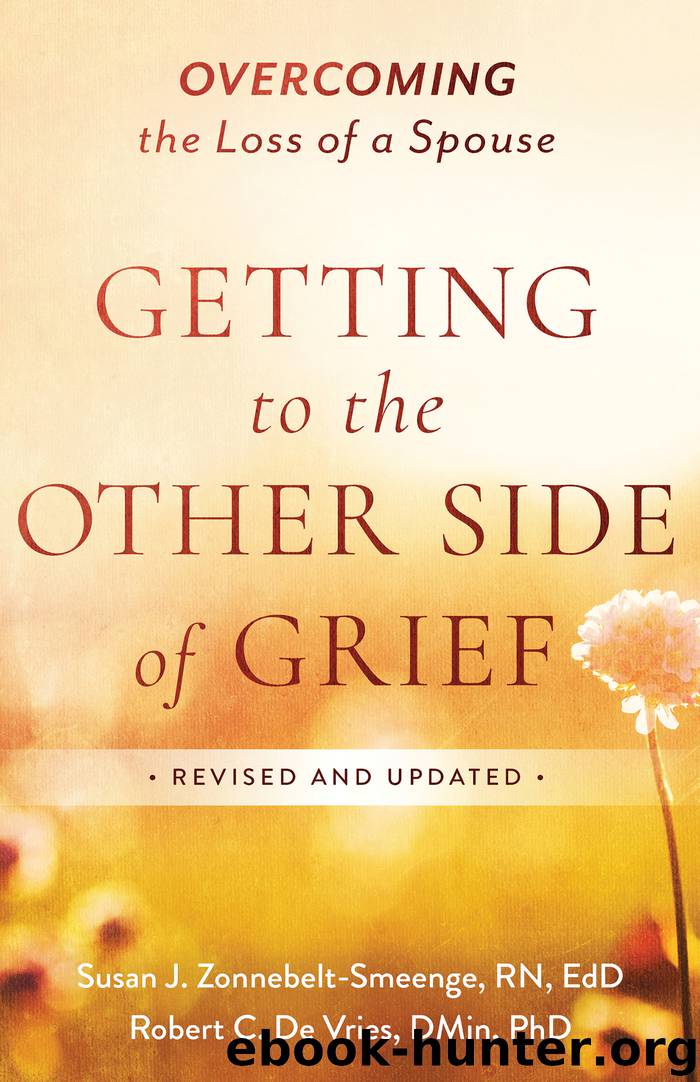Getting to the Other Side of Grief by Susan J. R.N. Zonnebelt-Smeenge

Author:Susan J. R.N. Zonnebelt-Smeenge
Language: eng
Format: epub
Tags: Grief;Bereavement—Psychological aspects | Bereavement—Religious;Aspects—Christianity | Grief | Grief—Religious aspects—Christianity;| Loss (Psychology) | Spouses—Death—Psychological aspects;SEL010000;FAM014000
ISBN: 9781493417681
Publisher: Baker Publishing Group
Published: 2019-06-12T16:00:00+00:00
Two Goals Focusing on “You”: Your Reconstructed Identity and Creating a New Volume
As you begin to accomplish aspects of the first three goals we’ve discussed related to your marriage and your spouse’s death, you may think that your spouse was the fortunate one. He or she “ran the race” and has completed what he or she needed to do on earth. Accepting that your spouse’s life is now complete and that it was his or her time to die is difficult to comprehend; however this is your new reality and a turning point when you realize you can’t hang on and move forward simultaneously. You will need to decide to let go and keep your spouse in the past.
The other aspect of your present reality is that you did not die. You are the one left behind, the one who needs to rediscover who you are without your spouse. Sorting through all the pieces of your past life with your spouse and trying to figure out how you are going to go on is hard work. Think about Humpty Dumpty falling off the wall. It seems that even all the king’s horses and all the king’s men couldn’t put him back together again. What are ways for you to slowly put your life back together again?
These other two goals of the five that are necessary to work through your grief turn your focus on you rather than your deceased spouse. The following section will help you understand how to revise your sense of identity and will give you suggestions for constructing a new normal.
Goal #4: Identify who you are now, without your spouse.
What This Goal Means for You: When Rick died Susan felt like her future died with him, as though it was ripped out of her grasp, and she might as well have died too. She enjoyed being married and sharing her life intimately with Rick. Even after his death, she felt more married than widowed at first! When filling out forms, she still wanted to check “married” even though she knew in her head that Rick had died. She certainly didn’t want to think of herself as “single” because that seemed to negate the twenty-four years of their marriage.
Transitioning from a married life back to a single status is certainly a huge adjustment—something most widowed people didn’t ask for or want. It just happens! One minute a person is married, and at his or her spouse’s last breath, he or she instantly becomes single. This puzzling juncture occurs in a flash, but you need considerable time and effort to figure out “Who am I now?” and accept yourself as single once again. In many ways, you may think you are in a time capsule transported back to adolescence when teenagers often feel insecure and uncertain, grasping for answers in figuring out their identities. Formulating a revised sense of self is like doing a puzzle that requires piece-by-piece effort but will eventually fit together if you work at it. That is definitely applicable to the grief work necessary to reconstruct yourself and your life.
Download
This site does not store any files on its server. We only index and link to content provided by other sites. Please contact the content providers to delete copyright contents if any and email us, we'll remove relevant links or contents immediately.
They Both Die at the End by Adam Silvera(9680)
Thirteen Reasons Why by Jay Asher(8745)
The Space Between by Michelle L. Teichman(6818)
Suicide Notes by Michael Thomas Ford(4703)
Tuesdays with Morrie by Mitch Albom(4608)
Suicide: A Study in Sociology by Emile Durkheim(2950)
The Checklist Manifesto by Atul Gawande(2746)
Tuesdays With Morrie by Mitch Albom(2636)
In the Woods by Tana French(2502)
Bossypants by Tina Fey(2429)
Robin by Dave Itzkoff(2302)
Olive Kitteridge by Elizabeth Strout(2275)
No Ashes in the Fire by Darnell L Moore(2253)
Reservoir 13 by Jon McGregor(2219)
End of Days by Sylvia Browne(2088)
Bus on Jaffa Road by Mike Kelly(2084)
All Things New by John Eldredge(2083)
Scar Tissue by Anthony Kiedis(2044)
No Time to Say Goodbye(2030)
